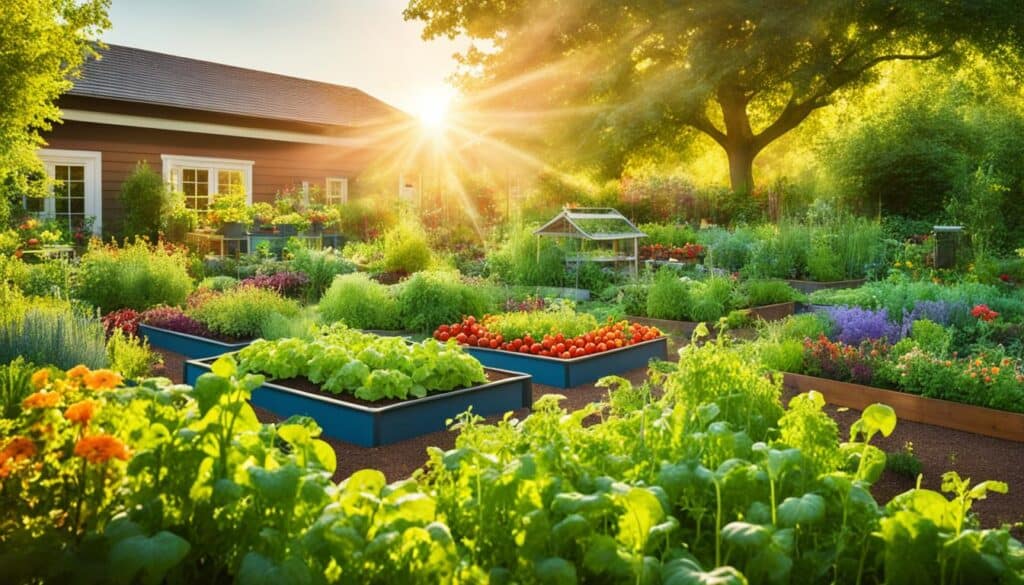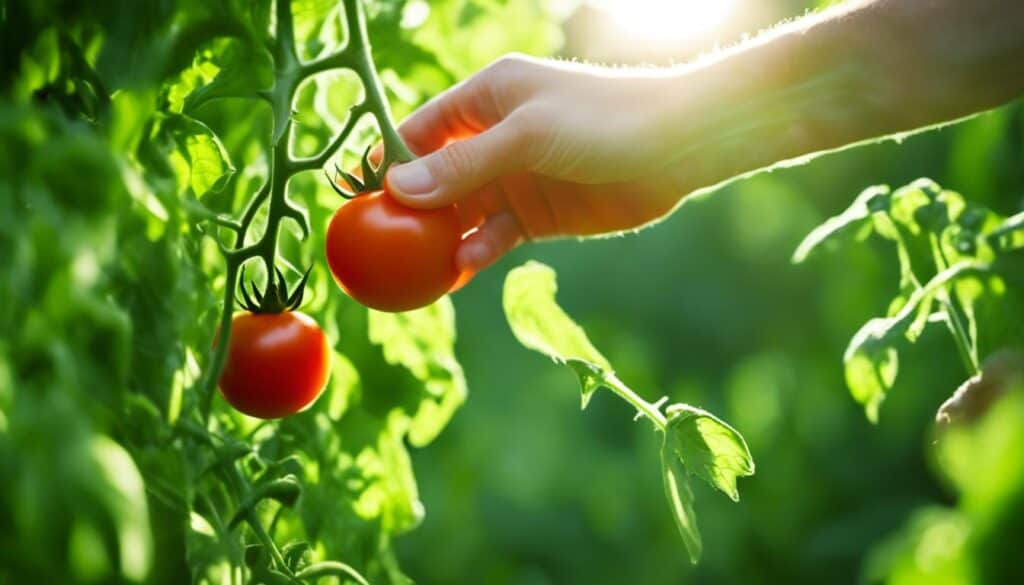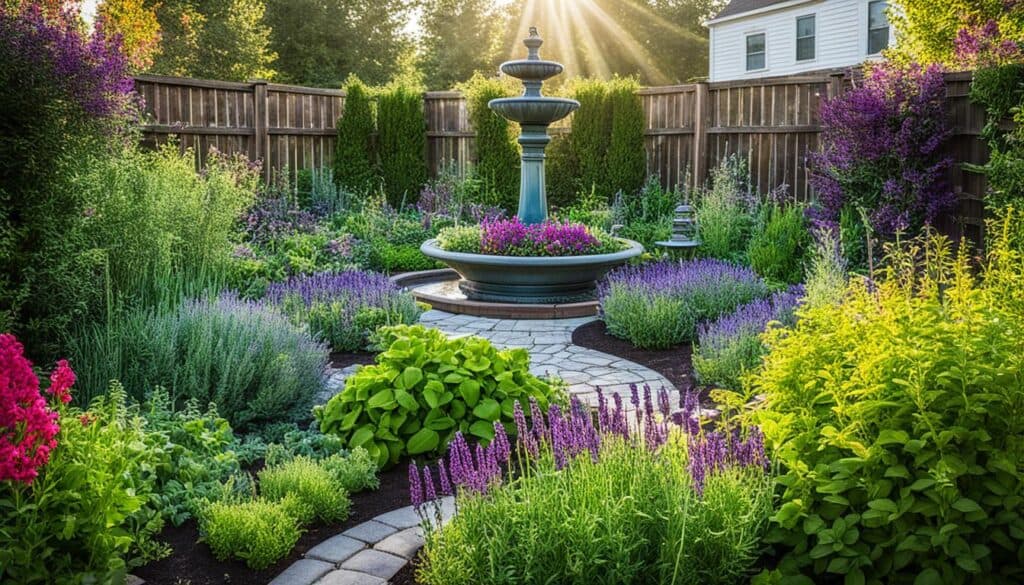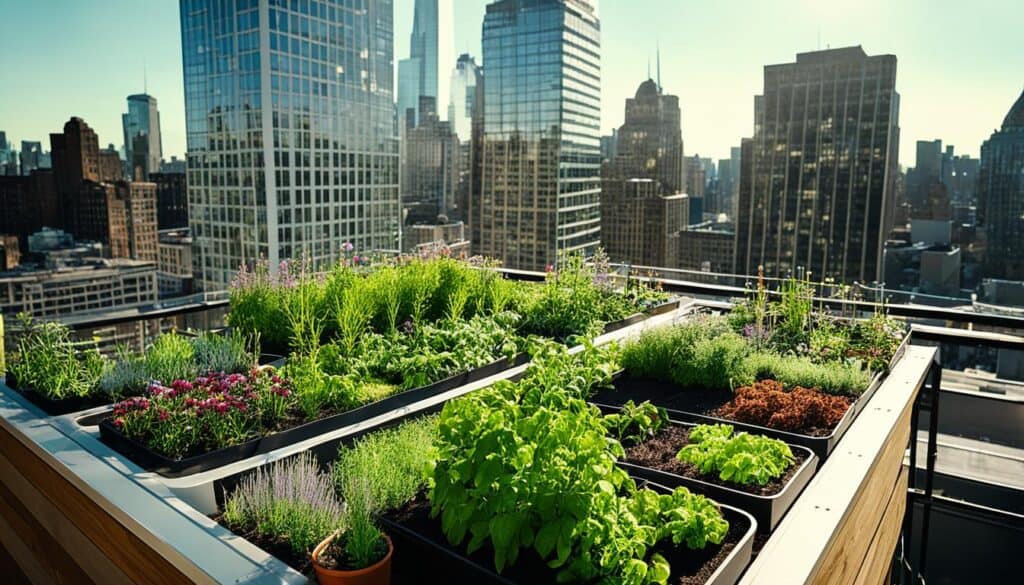Did you know that urban gardening is on the rise, with more and more people discovering the joys of growing their own food? In fact, studies show that kitchen gardening has increased by 300% in the past decade alone. This trend reflects a growing interest in sustainability, organic gardening, and the desire for homegrown vegetables that are fresh, flavorful, and free from harmful pesticides. Join me on my delightful journey in kitchen gardening as I share valuable tips and insights for cultivating your own urban oasis.
Key Takeaways:
- Kitchen gardening has seen a 300% increase in popularity in the past decade.
- Urban gardening allows for sustainable, organic, and homegrown vegetables.
- Growing your own food provides fresh and flavorful produce, free from harmful pesticides.
- Join me on a joyful journey as we explore valuable tips and insights in kitchen gardening.
Getting Started with Kitchen Gardening
To begin your own kitchen gardening journey, there are a few key steps to follow. First, gather the essential tools you will need:
- Gardening gloves
- A spade
- Watering cans
These tools will help you with various gardening tasks and ensure your comfort and safety while working in the garden.
Next, it’s important to prepare the soil for your kitchen garden. Start by removing any weeds or grass from the area you have chosen. This will prevent them from competing with your crops for nutrients and sunlight. Once the area is clear, you can improve the soil’s fertility by adding compost or organic matter. This will provide essential nutrients for your plants to grow strong and healthy.
When it comes to seed selection, it’s important to choose seeds that are suitable for your climate and the crops you want to grow. Fresh and high-quality seeds are essential for successful germination and healthy plant growth. Consider factors such as the days to maturity, sunlight requirements, and any specific growing conditions that the seeds may require.
By following these basic steps, you will be well on your way to starting your own kitchen garden and enjoying the rewards of growing your own food!
Choosing the Right Location for Your Kitchen Garden
In order to ensure the success of your kitchen garden, it is crucial to choose the right location. When it comes to kitchen gardening, the three key factors to consider are location selection, sunlight requirements, and proximity to a water source. By carefully assessing these factors, you can create an optimal environment for your plants to thrive.
Location Selection
When selecting a location for your kitchen garden, it’s important to keep in mind that most vegetables and herbs require at least 6 hours of direct sunlight per day. This means that you should choose an area that receives ample sunlight throughout the day. Look for a spot in your garden or yard that is not obstructed by trees, tall buildings, or other structures that may cast shadows. This will ensure that your plants receive the sunlight they need to grow and flourish.
Proximity to Water Source
Another important consideration when choosing the location for your kitchen garden is the proximity to a water source. Plants need consistent watering to stay healthy and productive. Therefore, it’s beneficial to select a location that is conveniently close to a water source such as a hose, sprinkler system, or rain barrel. This will make it easier for you to water your plants regularly and ensure they receive the moisture they need.
By taking into account these factors of location selection and proximity to a water source, you can create an optimal environment that meets the sunlight requirements and watering needs of your kitchen garden. This will provide a solid foundation for your plants and promote healthy growth, ultimately leading to a successful and bountiful harvest.
| Sunlight Requirements | Proximity to Water Source |
|---|---|
| Most vegetables and herbs require at least 6 hours of direct sunlight per day. | Choose a location that is conveniently close to a water source for easy watering and maintenance. |
| Ensure the selected area is not obstructed by trees, tall buildings, or other structures that may cast shadows. | Having a water source nearby will make it easier to water your plants regularly and ensure they receive the moisture they need. |
Planning and Designing Your Kitchen Garden
When it comes to kitchen gardening, careful planning and designing are crucial to maximize productivity and create an aesthetically pleasing space. By implementing strategies such as raised beds, companion planting, and vertical gardening, you can optimize your garden layout and make the most of your available space.
1. Raised Beds for Defined Growing Areas
Incorporating raised beds into your kitchen garden layout offers several advantages. Not only do they provide defined growing areas, but they also allow you to have better control over the soil quality. Raised beds can be easily constructed using materials such as wood or bricks, and they help improve drainage and prevent soil compaction. They provide a neat and organized structure to your garden, making it easier to manage and maintain.
2. Companion Planting for Enhanced Plant Health
Companion planting is a technique where different plants are grown together to benefit one another. By selecting compatible plant varieties, you can enhance plant health, deter pests, and improve pollination. For example, planting marigolds alongside your vegetables can help repel harmful insects, while allowing beneficial insects to thrive. Similarly, growing herbs like basil near tomatoes can enhance their flavor and ward off pests.
3. Vertical Gardening for Space Optimization
Vertical gardening is an excellent solution for maximizing space in small gardens. By utilizing vertical structures such as trellises, arbors, or hanging baskets, you can grow plants upwards instead of outwards. This not only increases your planting area but also adds a visually captivating element to your garden. Vertical gardening is particularly useful for vining plants such as cucumbers, beans, or even certain types of tomatoes. It allows you to grow more plants in a smaller footprint, making the most of limited space.
“The thoughtful integration of raised beds, companion planting, and vertical gardening can transform your kitchen garden into a functional and visually appealing space.”
To provide you with a visual reference, here’s an example of how you can design your kitchen garden layout:
| Section | Plants | Notes |
|---|---|---|
| 1 | Lettuce | Shaded area |
| 2 | Tomatoes | Vertical trellis |
| 3 | Herbs: Basil, Rosemary, Thyme | Companion planting |
| 4 | Cucumbers | Vertical trellis |
| 5 | Carrots, Radishes | Grouped together |
| 6 | Marigolds | Companion planting |
By following a well-thought-out design like the example above, you can create a harmonious and productive kitchen garden that maximizes space, enhances plant health, and adds beauty to your outdoor space.
Essential Care and Maintenance for Kitchen Gardens
Proper care and maintenance are vital for the health and productivity of your kitchen garden. To ensure the success of your crops, it is important to follow essential practices such as watering, fertilizing, pest control, and pruning.
Watering
Water is a crucial element for the growth of your plants. However, it is important to strike a balance between providing enough moisture and avoiding overwatering. The watering needs of your garden will vary depending on factors such as the type of plants, weather conditions, and soil type. Monitor the moisture levels in the soil and water your plants accordingly.
Fertilizing
Fertilizers play a key role in nourishing the soil and promoting healthy plant growth. Instead of relying on synthetic fertilizers, consider using natural alternatives or compost. These organic options provide essential nutrients to the soil without harming the environment. Apply fertilizers as per the instructions on the package, taking care not to over-fertilize, which can damage the plants.
Pest Control
Protecting your crops from common garden pests is essential for their growth and overall health. Instead of resorting to chemical pesticides, opt for organic pest control methods. These can include using companion planting techniques, natural predators, or homemade remedies. Regularly inspect your plants for any signs of pests and take appropriate measures to control their population.
Pruning
Pruning plays an important role in maintaining the shape and health of your plants. Regularly trim and prune your plants to remove dead or damaged branches, improve airflow and sunlight penetration, and prevent overcrowding. This will promote better growth and reduce the risk of diseases.
By implementing these essential care and maintenance practices, you can ensure the success of your kitchen garden. Pay attention to the watering needs, nourish the soil with natural fertilizers, protect your plants from pests, and regularly prune them to optimize their growth. With proper care, your kitchen garden will thrive and reward you with an abundant harvest of fresh and healthy produce.
Harvesting and Enjoying Homegrown Vegetables
The joy of kitchen gardening culminates in the harvest and enjoyment of your homegrown vegetables. As an avid gardener, I have learned valuable harvesting tips that ensure the best flavor and nutritional value of the crops I grow. Understanding the optimal time to harvest different vegetables is crucial for a successful kitchen garden. Let’s explore some of these tips and discover ways to preserve our bountiful harvest for year-round enjoyment.
Harvesting Tips
When it comes to harvesting, timing is key. Each vegetable has its own ideal stage of ripeness when it is at its peak flavor and nutrient content. Here are some general guidelines:
- Lettuce: Harvest when leaves are full-sized but still tender, before they become bitter.
- Tomatoes: Pick when they are firm and fully colored, and give a slight yield when pressed gently.
- Carrots: Pull them from the ground when the tops are orange and the root is crisp and sweet.
Remember to handle your harvested vegetables with care to avoid bruising or damaging them. Use a sharp knife or secateurs to cleanly cut the vegetables from the plant, and gently place them in a basket or container.
Vegetable Preservation
While it’s undoubtedly thrilling to enjoy your fresh produce right away, preserving your harvest allows you to savor the flavors of your kitchen garden throughout the year. Here are some popular methods of vegetable preservation:
- Canning: By using heat and airtight containers, you can preserve vegetables in jarred form to enjoy long after the growing season has ended.
- Freezing: Blanching and freezing vegetables helps retain their flavor, texture, and nutritional value.
- Pickling: Submerge your vegetables in a vinegar-based brine with spices to create tangy and crunchy pickles.
Experiment with different preservation methods to find the ones that best suit your taste preferences and available resources. Regardless of the technique you choose, preserving your homegrown vegetables is a delightful way to enjoy the fruits of your labor all year round.
Healthy Recipes Using Homegrown Vegetables
Nothing compares to the satisfaction of incorporating your homegrown vegetables into delicious and healthy recipes. Here are a few ideas to inspire your culinary adventures:
“There is no sincerer love than the love of food.” – George Bernard Shaw
| Recipe | Description |
|---|---|
| Vibrant Vegetable Stir-Fry | A colorful medley of stir-fried vegetables made with fresh homegrown produce. Serve over steamed rice or noodles for a satisfying meal. |
| Garden Fresh Caprese Salad | Layer juicy homegrown tomatoes, creamy mozzarella, and fragrant basil leaves to create a refreshing and visually appealing salad. |
| Roasted Root Vegetables | Toss a variety of homegrown root vegetables with olive oil, herbs, and spices, then roast until tender and caramelized for a hearty side dish. |
These recipes are just the beginning. Let your imagination and taste buds guide you as you create delectable dishes using your own homegrown vegetables.
The joy of kitchen gardening extends beyond the act of nurturing the plants. Harvesting our homegrown vegetables and incorporating them into delicious recipes not only delights our taste buds but also promotes a healthy and sustainable lifestyle. The freshness and flavors of homegrown produce elevate every dish, making it a truly rewarding experience.
Cultivating a Herb and Spice Garden
In addition to growing vegetables, a kitchen garden can also include a variety of herbs and spices. Cultivating a herb and spice garden adds a delightful array of flavors to your culinary creations. Whether you have a spacious plot or a compact balcony, you can create a bountiful herb garden that enhances your meals with freshness and aromatic richness. And don’t forget the allure of spice plants, which bring exotic flavors to your dishes, transporting you to new culinary horizons.
Culinary Herbs for Flavorful Delights
When it comes to culinary herbs, the options are endless. Start with popular herbs like basil, rosemary, and mint. These versatile plants can be used in various dishes, from pastas and salads to teas and cocktails. Embrace the pleasant fragrance of lavender for desserts or try growing thyme and oregano to infuse robust flavors into your savory recipes. Experiment with different herbs to find your favorites and elevate your cooking to new heights.
The Aromatic World of Spice Plants
Spice plants offer a fascinating range of flavors that can bring depth and complexity to your dishes. Consider growing plants such as cumin, coriander, and turmeric. Freshly ground spices from your own garden will provide an authentic and vibrant taste to your curries, marinades, and spice blends. Explore the rich palette of spices and embrace the opportunity to create unique culinary experiences right in your own backyard.
“Cultivating a herb and spice garden adds an incredible dimension to your cooking. The flavors and aromas elevate even the simplest dish into a gourmet experience.” – Me
Herb and Spice Garden Table
| Herbs | Flavors | Usage |
|---|---|---|
| Basil | Sweet, slightly peppery | Pasta, salads, pesto |
| Rosemary | Woody, pine-like | Roast chicken, potatoes |
| Mint | Cool, refreshing | Tea, cocktails, desserts |
| Thyme | Earthy, lemony | Soups, stews, roasted vegetables |
| Cumin | Earthy, warm | Curries, chili, spice blends |
| Coriander | Bright, citrusy | Curry pastes, salsas, marinades |
Explore the diverse world of herbs and spices, and delight in the flavors they bring to your kitchen creations. With a herb and spice garden, you can infuse every meal with the essence of freshness and discover new culinary possibilities.
Indoor Gardening: Greenery at Your Fingertips
Indoor gardening is a fantastic way to bring the beauty and benefits of plants into your home, even if you have limited outdoor space. Whether you live in an apartment or have a small house, cultivating indoor plants allows you to create a lush and vibrant atmosphere right in your living room or kitchen.
When it comes to indoor gardening, choosing the right plants is crucial. Consider your available light conditions and space constraints. Some indoor plants thrive in low light and require minimal maintenance, making them perfect for busy individuals or those with limited exposure to natural sunlight. Others, however, thrive in bright, indirect light and can transform any space into a stunning indoor oasis.
To ensure your indoor plants receive the necessary light, you can also explore the use of grow lights – artificial light sources designed to provide the right spectrum of light for plant growth. Grow lights are especially beneficial for plants that require more sunlight than your indoor environment can provide. By strategically positioning grow lights, you can supplement natural light and create optimal conditions for your plants to flourish.
“Indoor gardening allows you to create a serene environment while enjoying the benefits of plants right at your fingertips.”
In addition to traditional soil-based gardening, indoor gardening also opens up the possibilities of hydroponics – a soil-less growing method that uses nutrient-rich water solutions to deliver the necessary elements directly to plants’ roots. Hydroponics offers several advantages, including faster growth rates and improved resource efficiency. It’s a fascinating way to experiment and cultivate plants indoors, and it can be particularly beneficial for those with limited space or soil quality concerns.
Benefits of Indoor Gardening
Indoor gardening brings a host of advantages beyond adding greenery to your living space. Here are a few benefits you can enjoy:
- Improved Air Quality: Indoor plants act as natural air purifiers, absorbing harmful pollutants and releasing oxygen. They can help purify the air and create a healthier indoor environment for you and your family.
- Enhanced Well-being: Surrounding yourself with plants can positively impact your mental and emotional well-being. Studies have shown that indoor gardening can reduce stress levels, improve mood, and increase productivity.
- Connection with Nature: Indoor gardening allows you to stay connected with nature, even when spending most of your time indoors. It brings a sense of tranquility and harmony to your living space.
Now that you’ve learned about the joys and benefits of indoor gardening, it’s time to explore the exciting world of indoor plants and discover the perfect additions for your home.
| Indoor Plants | Light Requirements | Watering Needs | Favorite Features |
|---|---|---|---|
| Snake Plant | Low to bright indirect light | Low | Air-purifying properties and striking foliage |
| Pothos | Low to bright indirect light | Low | Vibrant trailing vines and ease of care |
| Fiddle Leaf Fig | Bright indirect light | Moderate | Statement-making large leaves |
| ZZ Plant | Low to bright indirect light | Low | Drought-tolerant and glossy foliage |
| Ferns | Low to bright indirect light | Moderate to high | Lush and feathery fronds |
Sustainable Gardening in Small Spaces
When it comes to kitchen gardening, sustainability is key. By implementing eco-friendly practices in your small space garden, you can actively contribute to conserving resources and reducing environmental impact. Let’s explore some sustainable gardening techniques that are perfect for small spaces.
Organic Fertilizers and Natural Pest Control
In my journey of sustainable gardening, I have found that using organic fertilizers and natural pest control methods is not only environmentally friendly but also promotes healthier plant growth. By avoiding chemical-based fertilizers and pesticides, you can ensure that your kitchen garden remains free from harmful toxins. Instead, opt for natural alternatives such as compost, manure, or organic pest repellents.
Vertical Gardening for Small Spaces
One innovative technique that has revolutionized small space gardening is vertical gardening. By utilizing vertical structures like trellises, hanging baskets, or wall-mounted planters, you can maximize your growing area while adding a beautiful aesthetic to your garden. Vertical gardening is perfect for growing vining plants like tomatoes, cucumbers, or beans, making efficient use of limited space.
Container Gardening for Versatility
Another great option for small space gardening is container gardening. Whether you have a balcony, patio, or even just a windowsill, containers allow you to cultivate a variety of plants. This versatile technique allows for easy mobility and flexibility, especially if you have limited outdoor space. Select containers of different sizes and shapes to accommodate various herbs, vegetables, or flowers, and watch your garden thrive.
Composting: Nature’s Nourishment
In sustainable gardening, composting plays a crucial role. By recycling organic waste materials such as kitchen scraps, fallen leaves, and garden trimmings, you can create nutrient-rich compost to feed your garden naturally. Not only does composting reduce waste sent to landfills, but it also improves soil fertility and promotes healthy plant growth. It’s an easy and eco-friendly practice that every small space gardener should embrace.
“Sustainable gardening isn’t just about what you grow, but also how you grow it. By adopting eco-friendly practices and utilizing innovative techniques, even the smallest of spaces can become thriving and sustainable gardens.” – John Green
The Benefits of Sustainable Gardening in Small Spaces
Sustainable gardening in small spaces offers numerous benefits, both for you and the environment. Not only can you enjoy the satisfaction of growing your own fresh and organic produce, but you can also reduce your carbon footprint and contribute to a greener planet. By implementing sustainable practices such as using organic fertilizers, practicing natural pest control, embracing vertical and container gardening, and implementing composting, you can create a truly eco-friendly and bountiful kitchen garden.
| Benefits of Sustainable Gardening in Small Spaces | Description |
|---|---|
| Environmental Conservation | By avoiding chemical fertilizers and pesticides, you protect the soil, water, and local ecosystem. |
| Reduced Waste | Composting organic waste reduces landfill waste and closes the loop in the cycle of nutrients. |
| Optimal Space Utilization | Vertical and container gardening techniques allow for maximum productivity in small areas. |
| Healthier and Tastier Produce | Organic gardening methods result in fresher and more flavorful fruits, vegetables, and herbs. |
| Cost Savings | Growing your own food reduces grocery bills and allows for budget-friendly gardening practices. |
| Connection with Nature | Gardening is a therapeutic activity that fosters a deeper connection with the natural world. |
Conclusion
Kitchen gardening is an incredibly fulfilling and rewarding journey that brings immense joy and satisfaction. Through the act of growing your own food, you not only nourish your body but also foster a deeper connection with nature.
By carefully planning, nurturing, and harvesting your kitchen garden, you can enjoy the abundance of homegrown vegetables and herbs, allowing you to embrace a healthier and more sustainable lifestyle. Whether you have a small space or a larger garden, cultivating your own food brings a sense of self-sufficiency and accomplishment.
Engaging in kitchen gardening provides numerous benefits, including the opportunity to savor the freshest and most flavorful ingredients in your meals. It allows you to promote healthy living by knowing exactly what goes into your food and avoiding harmful chemicals and pesticides.
Embark on your own joyful journey in kitchen gardening and experience the numerous rewards it offers. Connect with nature, enjoy the taste of homegrown goodness, and live a more self-sufficient and sustainable life. Start today and cultivate your very own kitchen garden, celebrating the wonders of nature’s bounty.










Leave a Reply